The Intel SSD 330 Review (60GB, 120GB, 180GB)
by Anand Lal Shimpi on August 1, 2012 12:01 AM ESTThe Test
| CPU | Intel Core i7 2600K running at 3.4GHz (Turbo & EIST Disabled) - for AT SB 2011, AS SSD & ATTO |
| Motherboard: | Intel DH67BL Motherboard |
| Chipset: | Intel H67 |
| Chipset Drivers: | Intel 9.1.1.1015 + Intel RST 10.2 |
| Memory: | Corsair Vengeance DDR3-1333 2 x 2GB (7-7-7-20) |
| Video Card: | eVGA GeForce GTX 285 |
| Video Drivers: | NVIDIA ForceWare 190.38 64-bit |
| Desktop Resolution: | 1920 x 1200 |
| OS: | Windows 7 x64 |
Random Read/Write Speed
The four corners of SSD performance are as follows: random read, random write, sequential read and sequential write speed. Random accesses are generally small in size, while sequential accesses tend to be larger and thus we have the four Iometer tests we use in all of our reviews.
Our first test writes 4KB in a completely random pattern over an 8GB space of the drive to simulate the sort of random access that you'd see on an OS drive (even this is more stressful than a normal desktop user would see). I perform three concurrent IOs and run the test for 3 minutes. The results reported are in average MB/s over the entire time. We use both standard pseudo randomly generated data for each write as well as fully random data to show you both the maximum and minimum performance offered by SandForce based drives in these tests. The average performance of SF drives will likely be somewhere in between the two values for each drive you see in the graphs. For an understanding of why this matters, read our original SandForce article.
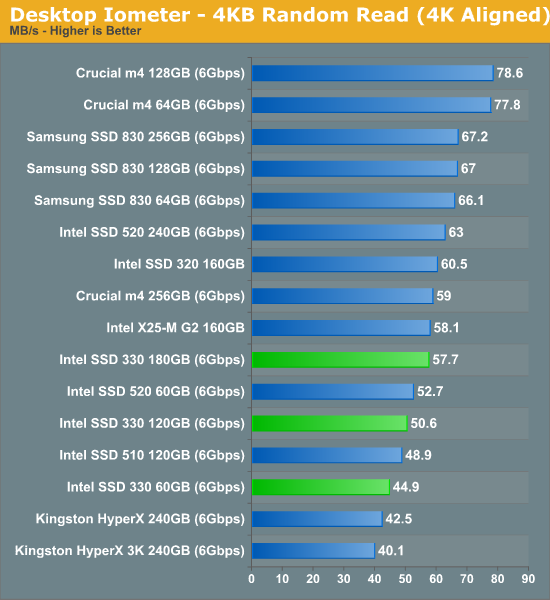
At similar capacities, the 330 and 520 offer nearly identical random read performance. The old X25-M G2 actually offers better random read performance than many of the newer drives, although most users would be hard pressed to tell the difference in actual usage.
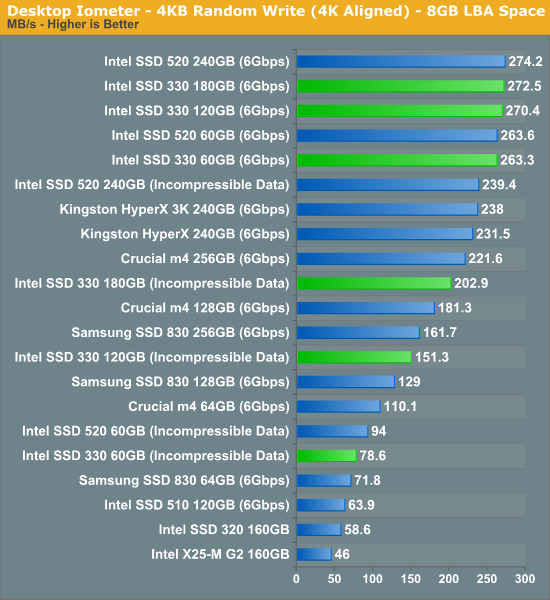
Random write performance is great with easily compressible data, but even when faced with data that can't be reduced the Intel SSD 330 does very well. Once again performance is very similar between the 330 and 520 drives.
Many of you have asked for random write performance at higher queue depths. What I have below is our 4KB random write test performed at a queue depth of 32 instead of 3. While the vast majority of desktop usage models experience queue depths of 0 - 5, higher depths are possible in heavy I/O (and multi-user) workloads:
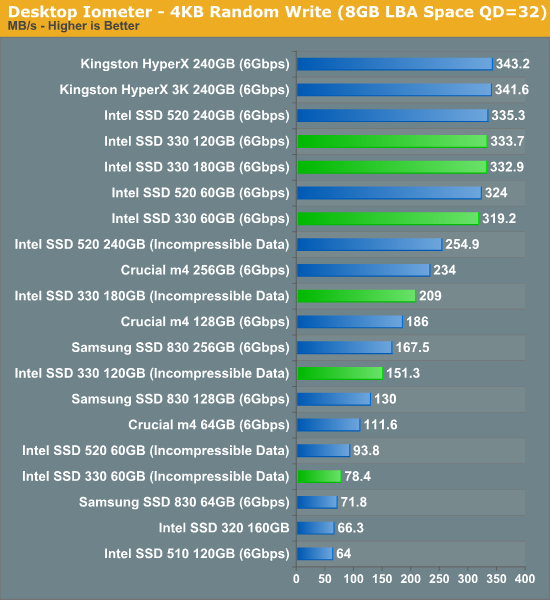
Sequential Read/Write Speed
To measure sequential performance I ran a 1 minute long 128KB sequential test over the entire span of the drive at a queue depth of 1. The results reported are in average MB/s over the entire test length.
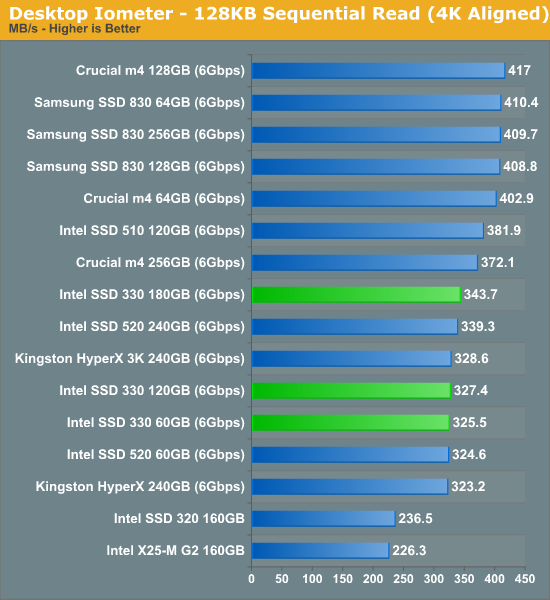
Low queue depth sequential read performance is good but not exactly class leading. Once again there's no real performance difference between the 330 and 520.
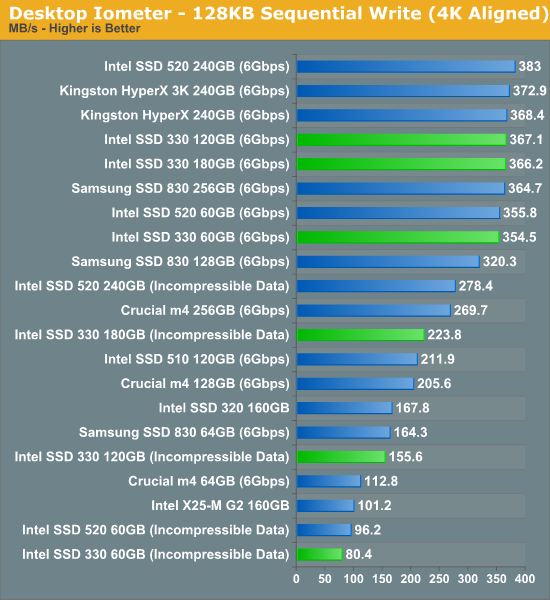
Sequential write performance with incompressible data is the biggest downside to any SandForce based drive. Try copying a compressed video or photos to the drive and you'll get speeds south of 230MB/s. The 60GB drive can only manage 80MB/s with incompressible data, that's actually no faster than the old Intel X25-M.
AS-SSD Incompressible Sequential Performance
The AS-SSD sequential benchmark uses incompressible data for all of its transfers. The result is a pretty big reduction in sequential write speed on SandForce based controllers.

Here we see what higher queue depth sequential reads look like. The 330 gets close to 500MB/s but never actually exceeds it.
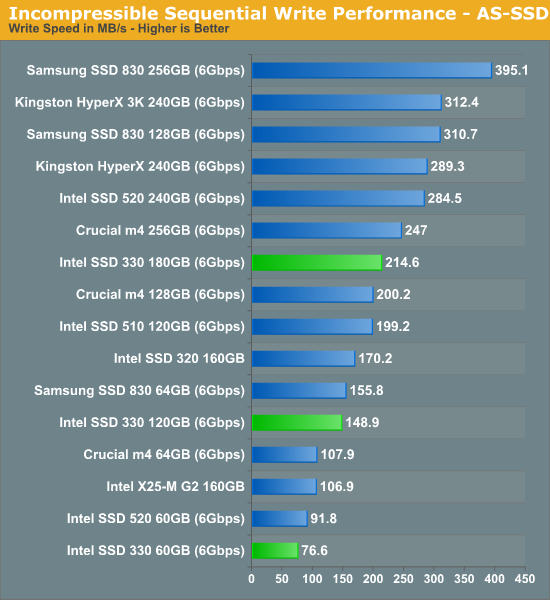
Incompressible sequential write performance, again, doesn't look very good.










64 Comments
View All Comments
antef - Wednesday, August 1, 2012 - link
And, holy crap, Anand's chart is wrong, the m4 128 GB is now only $106 at Amazon. That's a steal!nextel2010 - Tuesday, October 2, 2012 - link
At this moment, Amazon has the Samsung 830 128GB at $89.99!! If I didn't already have a 128GB and 256GB already, I'm all over that one....owned66 - Wednesday, August 1, 2012 - link
i have 2 of these in raid 0HD tune bench it stays at 1000 MB/s then goes up and down then stays at 700 MB/s then goes back to 1000
im using a x77 motherboard
and also using the 6Gb/s port (not the marvell one)
Movieman420 - Wednesday, August 1, 2012 - link
I've been following the SSD endurance thread at XS for some time. There's one 64gb M4 that hit 0 MWI at 172TB of writes and is still chugging along at 1,.250+ TBs (that's 1.25 PB!!). Ofc not every drive is the same. There is a chart of the currently running endurance tests on the last page or 2 usually. To sum it up...nand endurance is not an issue as Anand stated.They have a Samsung 830 that just hit 3PBs!....it's mwi said the nand was worn out at 828TB writes...lmao
MrSpadge - Wednesday, August 1, 2012 - link
It's disappointing to see this drive switch to 9.5 mm when actually any SSD could be 7 mm standard. And Intel were the first to offer this (although with that stupid voided warrenty).MarsMSJ - Wednesday, August 1, 2012 - link
Anand should of touched on OSX and Intel's new drives even at the risk of sounding like a broken record. There some of us praying for the day Intel comes out with a new drive that works on OSX.Unfortunately, Samsung appears to be your best bet on OSX. I used a 320 series 160 GB drive and it just behaved poorly when I was using 150 GB of it. Not sure if it had anything to do with Repair Disk. Every other day OSX would recommend I run it because it believed my drive was corrupt. Sometimes it would even boot me right into Disk Utility. I ran Lion and Windows 7 in VMware fusion.
Strangely enough, the 320 behaved like these 330s in their "run into a corner" scenario.
kaelynthedove78 - Wednesday, August 1, 2012 - link
I noticed that you tested with a highly non-standard configuration, with EIST disabled.Has the Sandforce bug that causes the performance to plummet if EIST is enabled been fixed?
Nobody in their right mind would run a home desktop/laptop with EIST disabled..
jwcalla - Wednesday, August 1, 2012 - link
Hmmm... this is interesting. Where can I find more info about this? I haven't noticed such behavior yet but maybe I haven't been looking hard enough.Kristian Vättö - Thursday, August 2, 2012 - link
It's been fixed from what I know, or at least Anand told me to just leave those enabled (my setup is running normal settings as you can see in some of our recent SSD reviews). Anand has probably just left those settings to be what they were before.mattlach - Wednesday, August 1, 2012 - link
I presume the Vertex 4 is not in the comparison table due to its poor read speed when reviewed by Anandtech?Anandtech still needs to revisit the Vertex 4. The two firmware releases since launch have completely transformed the drive, and I wouldn't be surprised to see it near the top.